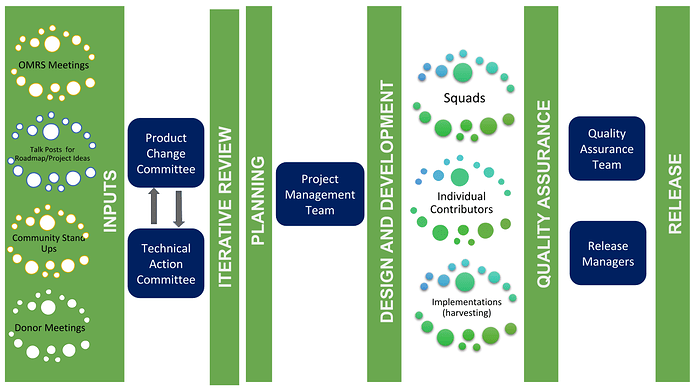At OpenMRS, we embrace and celebrate the work that small teams or groups do in our community because it’s become a proven way for us to solve problems together. Over the next few months, we’re very likely to get to a point where some of the innovative work currently being done by a small group or team will be ready to move to the next stage. Given the wider implications for the community and the teams’ work, we’ll have some decisions to make about how the community proceeds.
This is already starting to happen to some degree with Microfrontends, OpenMRS Flow, and migration. As a result, the past few Strategy discussions have raised excellent questions and generated a number of ideas around our decision making model and the relationship between the community and small groups/squads.
It’s time to move the conversation about decision making to the next stage. By figuring out and trying some adjustments to our decision making and governance model that allows our model to work more smoothly at scale, we’ll be in a better position to support and work more quickly with small teams when they need us.
What happens next?
Let’s build off of the questions and points raised during recent discussions to put together some cohesive proposals for community conventions that we can discuss and improve together.
I’ll kick this effort off by posting a series of proposals on Talk over the next several weeks. Each one will have it’s own Talk thread and we can use the #strategy-and-operations Slack channel to chat or ask questions about any aspect of a proposal.
How can you contribute to these conventions?
These are not going to be perfect by any means and I expect that they will include some things some people agree with and disagree with. Feel free to read them over and point out what you like, what you don’t, what you think is missing, and/or what you think needs to be beefed up, toned down, or tossed out. Your ideas, perspectives, and feedback will lead to better conventions that reflect our community’s values.
If you’d like to be more actively involved and help determine when each proposal is “good enough” for us to try out over the next 3-4 months, let me know! Several people, including @paul, @burke, @jdick, @wanyee, and @c.antwi, have already voiced their willingness to help in this way.
Want more context or background?
Here are some of the questions that have come up during recent Strategy discussions:
- As the work of small and nimble teams like the Microfrontend Squad advances, how do they move from working on something that’s experimental to something that is accepted and adopted by the larger community?
- When small groups or squads working on a project are trying to make a decision about something that has implications for the wider community, how do they proceed in a timely way, while remaining open to input from the community?
- If the squad has decision-making authority over their scope, does this change when a squad or team is working on something that has wider implications for the community? If so, when does that shift happen, and who then makes the decision?
- How do we move something that a team or squad is working on into core? What is this process?
If you want to know more about the discussion and how these questions came up, I encourage you to listen to the recordings or look over the notes.
https://notes.openmrs.org/2019-06-27-Strategy-and-Operations-Call
https://notes.openmrs.org/2019-07-11-Strategy-and-Operations-Call


